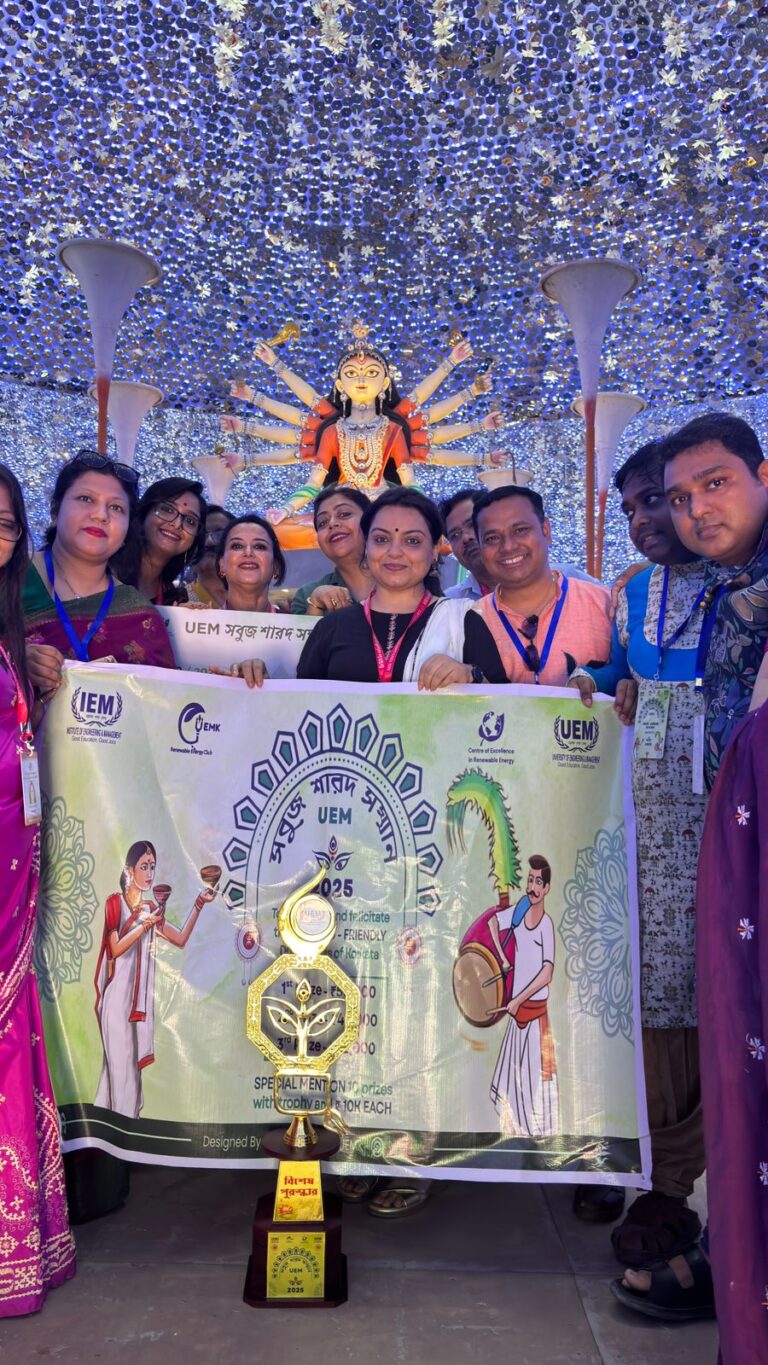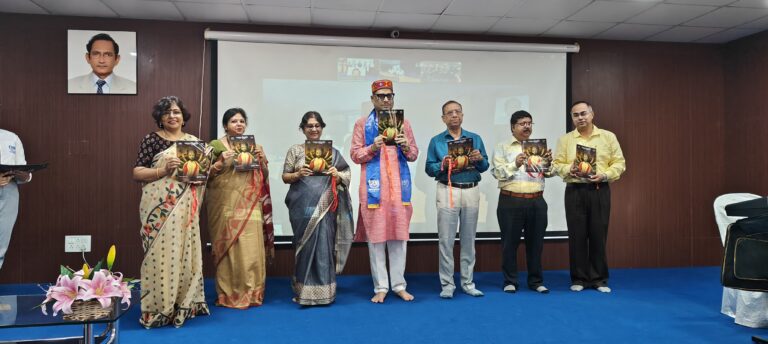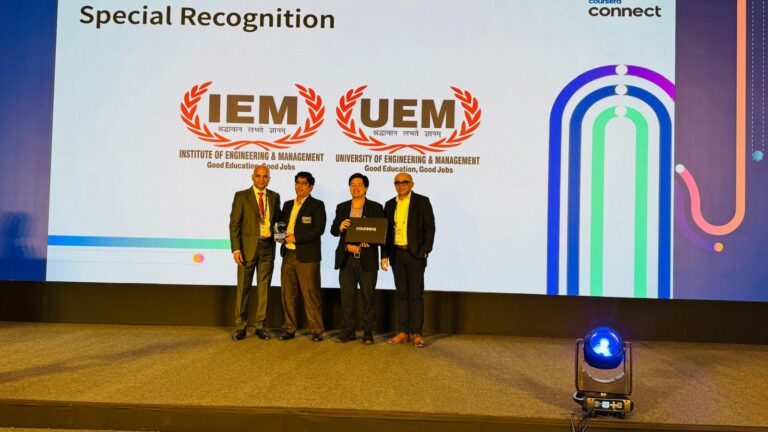University of Engineering and Management Kolkata
Laboratory
Chemistry Laboratory
Description
Chemistry Laboratory is a place where students can gain valuable hands-on experiences on the materials, exposure to reactions, experiments and equipments that they have learned in theory class. Hands-on laboratory experiences are very crucial for the development of basic problem-solving ability and critical-thinking based skills. Constant guiding students in hands-on laboratory experiments empower students to prepare themself for high-technology careers by fostering skills sought by potential employers. Students are involved to examine water quality, viscosity coefficient and surface tension of various samples, analyze different acid-base and redox samples applying laboratory apparatus and instruments. These are very important activities for gaining applied knowledge in chemistry and improving skills of science.
Equipments available
- Weighing balance
- Ultrasonic Bath Sonicator
- Magnetic Stirrer cum Hotplate
- Double distillation unit
- Ostwald Viscometer
- Stalagmometer
- Specific gravity bottle
- Digital Potentiometer
- Digital Conductivity Meter
- Digital pH Meter
- Thermometer
- Digital Stop watch
- Water bath
- Burette
- Burette stand
- Graduated Pipette
- Sucker
- Conical flask
- Volumetric flask
- Measuring cylinder
- Beaker
- Funnel
- Spatula
- Wash Bottles
- Watch Glass
Physics Laboratory
Description
The Physics Laboratory Of University of Engineering and Management, Kolkata consists of two units, a General laboratory and an Optics laboratory. The laboratory has 12 different experimental set ups. There are several set ups of each experiment for the benefit of the students. The Optics laboratory is basically a very well designed dark room to carry out optics experiments. The students apply and verify their theoretical understanding of optics, mechanics, electromagnetism, electronics, quantum physics, statistical physics and solid state physics by performing various experiments. The students are also encouraged to design various innovative devices which involve application of their theoretical understanding and practical experience gained through this Physics course.
Equipments available
- Laser Apparatus
- Newton’s Ring Apparatus
- Plank’s Constant using Photocell
- Rigidity Modulus by Static method
- Specific charge by mass(e/m) of electron by JJ Thomson method
- Stefan’s law
- Screw driver setup
- Young’s modulus
- Hall coefficient of semiconductor
- Numerical Aperture and energy losses related to Optical Fiber Band Gap
- Measuring tape
- Magnifying glass
- Stop clock
- Bar pendulum
- Melde experiment
- Diode laser 5 mW
- Red power supply
- LASER DETECTOR
- Na Vapour lamp
Basic Electrical Engineering Laboratory (ESC-191)
Description
The Basic Electrical Engineering laboratory is utilized for performing experiments related to fundamentals of Electrical Engineering, which common to all first year undergraduate B.Tech students of the university. This laboratory is located in B2LG 4.1 and consists of 22 fully equipped setup benches to carry out numerous fundamental experiments in Electrical Engineering. The experiments are designed to expose students to the practical executions of the fundamental theories of Electrical Engineering. This Lab covers all the basic devices that serve as the most basic building block of almost all electrical devices. This Lab lays a firm foundation of what is to be learned throughout the engineering curriculum.
Electrical Setup
Some of the electrical setup benches in this lab as a part of the ESC191 curriculum are
- RLC- SERIES CIRCUIT TEST BENCH.
- RLC- PARALLEL CIRCUIT TEST BENCH.
- FLUORESCENT LAMP SETUP BENCH.
- CARBON AND TUNGSTEN LAMPS SETUP BENCH.
- AMMETER AND WATTMETER CALIBRATION SETUP.
- POWER MEASUREMENT OF THREE PHASE CIRCUIT SETUP BENCH BY TWO WATTMETER METHOD.
- OPEN AND SHORT CIRCUIT TEST BENCH OF A SINGLE PHASE TRANSFORMER.
- SECTIONAL VIEW MODEL OF DC SHUNT MOTOR AND GENERATOR.
- SPEED CONTROL SETUP BENCH OF DC SHUNT MOTOR.
- NO LOAD CHARACTERISTICS SETUP BENCH OF D.C SHIUNT GENERATOR.
- SECTIONAL VIEW MODEL OF LT SWITCHGEAR.
Equipment
Each experimental bench is equipped with variable AC and DC power supplies with adequate protections, which enables students to carry out the experiments in an electrically safe environment. The lab is equipped with energy meters, power meters, voltmeters, ammeters, various size and type of transformers, various types and sizes of motors and many essential devices.
Basic Electronics Engineering Laboratory
Description
This is a first level laboratory in which students from various disciplines are introduced with fundamentals of Electronics Engineering for the first time and are trained with preliminary of electronic components and devices. This laboratory deals with basic electronic devices and their characteristics and applications. The students are introduced with these devices so that they are capable of designing various electronic circuits for real life applications. This laboratory is furnished with basic electronic components such as diodes, transistors, FETs, OP-AMP as well as equipment such as advanced digital multimeters, function generators, CROs, DSOs.
Equipment
- 10MHz Function-Pulse Generator with 40MHz frequency counter
- 30 MHz Cathode Ray Oscillator
- Regulated Power supply (-15V to + 15V, 0.5A)
- DC Regulated Power supply (-30V to + 30V, 1A)
- DC Power supply (± 0-15V)
- Function/Arbitrary waveform generator (5MHz, 125MSa/s)
- Digital storage oscilloscope (200MHz, 1 GSa/s)
- Function generator (3MHz, -40db)
- Digital T-RMS Multimeter (1000V DC, 750V AC, 10MHz)
- Diode Trainer Kit
- OP-AMP parameters, application, characteristics Trainer Kit
- Rectifier Trainer Kit
Workshop/Manufacturing Practices
Description
The workshop/Manufacturing Practices lab is a place where students get their imaginations into a reality. In this particular lab, students get the chance to do hands-on practice which is referred to as a manufacturing process. This practice really helps a student to develop thinking about choosing a proper material based on the applications. Also helps to relate the drawing to make any particular item, and accordingly measure with the help of various measuring instruments. In this laboratory safety and precautions is very important, by which students get the knowledge about the usage of various cutting tools as well as handling the machines.
Equipment
- Bench vice
- Scriber
- Hacksaw
- Flat file
- Round File
- Semicircular file
- Triangular File
- Letter punch
- Number punch
- Ball peen hammer
- Sledge hammer
- Engineering steel rule
- Vernier caliper
- Micrometer
- Radius gauge
- Feller gauge
- Thread pitch gauge
- Outside caliper
- Inside caliper
- Odd-leg caliper
- Divider
- 3D printer
- M.S. plate
- Wooden block
- Rip saw
- Tenon saw
- Rasp file
- Iron jack planner
- Carpenter Vice
- Manual Metal Arc Welding Machine
- Electrode holder
- Earthing clamp
- Iron Table
- Chipping hammer
- Face shield
- Leather gloves
- Consumable electrode
- Tongs
- Lathe machine
- Bench grinder
- Pillar drilling machine
- Power saw
- Cope & Drag
- Swab
- Riddle
- Shovel
- Hand rammer
- Strike off bar
- Draw spike
- Gate cutter
- Towel
- Bellow
- Furnace
- Crucible
- Bentonite
- Green sand
- Oxygen cylinder
- Acetylene cylinder
- Oxygen regulator
- Acetylene regulator
- Gas welding torch
- Anvil











